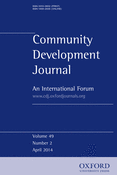-
Views
-
Cite
Cite
Katia Balassiano, Marta Maria Maldonado, Civic spaces in rural new gateway communities, Community Development Journal, Volume 49, Issue 2, April 2014, Pages 262–279, https://doi.org/10.1093/cdj/bst029
Close - Share Icon Share
Abstract
Rural new gateway communities in the United States – those communities that have become destinations for growing numbers of immigrant and non-immigrant Latino/as and other new populations since the 1990s – face great challenges in their integration efforts. Traditional institutional mechanisms and spaces, like city hall, where people are encouraged to voice their concerns and interests do not provide equal opportunities for participation in liveability-related decisions for newly incorporated populations. Besides language barriers, the formal spaces and norms of communication dictated by America's legal system can be foreign to newcomers. Yet, improving liveability for all segments of the community hinges on inclusive governance. Knowing what places are used for community discussions, by whom, and why can inform and help develop more effective and inclusive institutional participatory practices and venue choices, and also lead to more effective community integration efforts. This article discusses findings from a study which sought to explore where different segments of a rural Iowa community undergoing demographic and sociocultural change go to discuss their needs and concerns, and to what degree these spaces facilitate individual and collective empowerment. The work we present extends the theoretical and urban-focused public space literature through a case study of a rural new gateway.



